CHEVROLET AVALANCHE 2005 1.G Owners Manual
Manufacturer: CHEVROLET, Model Year: 2005, Model line: AVALANCHE, Model: CHEVROLET AVALANCHE 2005 1.GPages: 496, PDF Size: 3.25 MB
Page 391 of 496
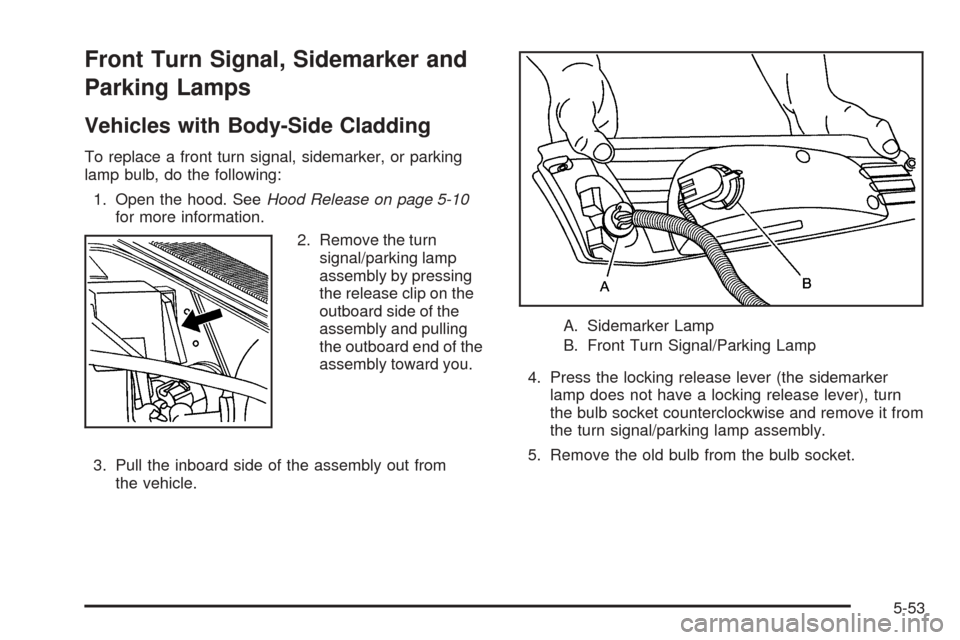
Front Turn Signal, Sidemarker and
Parking Lamps
Vehicles with Body-Side Cladding
To replace a front turn signal, sidemarker, or parking
lamp bulb, do the following:
1. Open the hood. SeeHood Release on page 5-10
for more information.
2. Remove the turn
signal/parking lamp
assembly by pressing
the release clip on the
outboard side of the
assembly and pulling
the outboard end of the
assembly toward you.
3. Pull the inboard side of the assembly out from
the vehicle.A. Sidemarker Lamp
B. Front Turn Signal/Parking Lamp
4. Press the locking release lever (the sidemarker
lamp does not have a locking release lever), turn
the bulb socket counterclockwise and remove it from
the turn signal/parking lamp assembly.
5. Remove the old bulb from the bulb socket.
5-53
Page 392 of 496
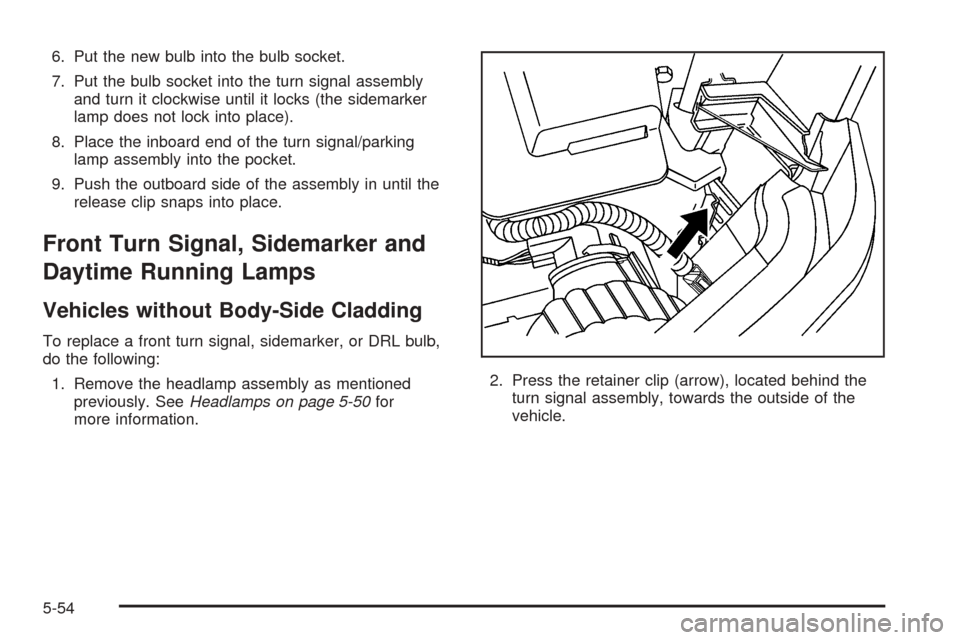
6. Put the new bulb into the bulb socket.
7. Put the bulb socket into the turn signal assembly
and turn it clockwise until it locks (the sidemarker
lamp does not lock into place).
8. Place the inboard end of the turn signal/parking
lamp assembly into the pocket.
9. Push the outboard side of the assembly in until the
release clip snaps into place.
Front Turn Signal, Sidemarker and
Daytime Running Lamps
Vehicles without Body-Side Cladding
To replace a front turn signal, sidemarker, or DRL bulb,
do the following:
1. Remove the headlamp assembly as mentioned
previously. SeeHeadlamps on page 5-50for
more information.2. Press the retainer clip (arrow), located behind the
turn signal assembly, towards the outside of the
vehicle.
5-54
Page 393 of 496
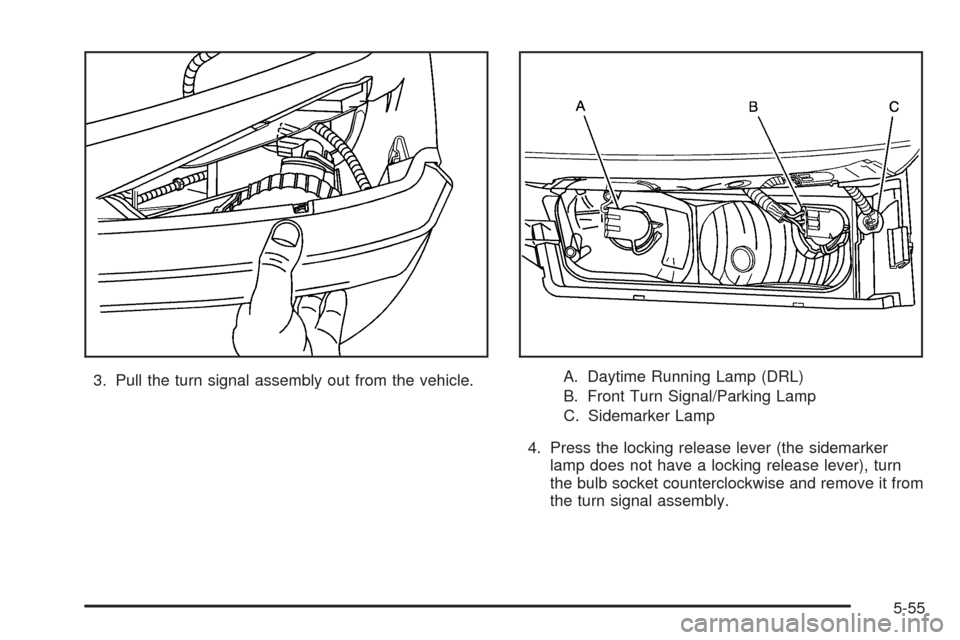
3. Pull the turn signal assembly out from the vehicle.A. Daytime Running Lamp (DRL)
B. Front Turn Signal/Parking Lamp
C. Sidemarker Lamp
4. Press the locking release lever (the sidemarker
lamp does not have a locking release lever), turn
the bulb socket counterclockwise and remove it from
the turn signal assembly.
5-55
Page 394 of 496
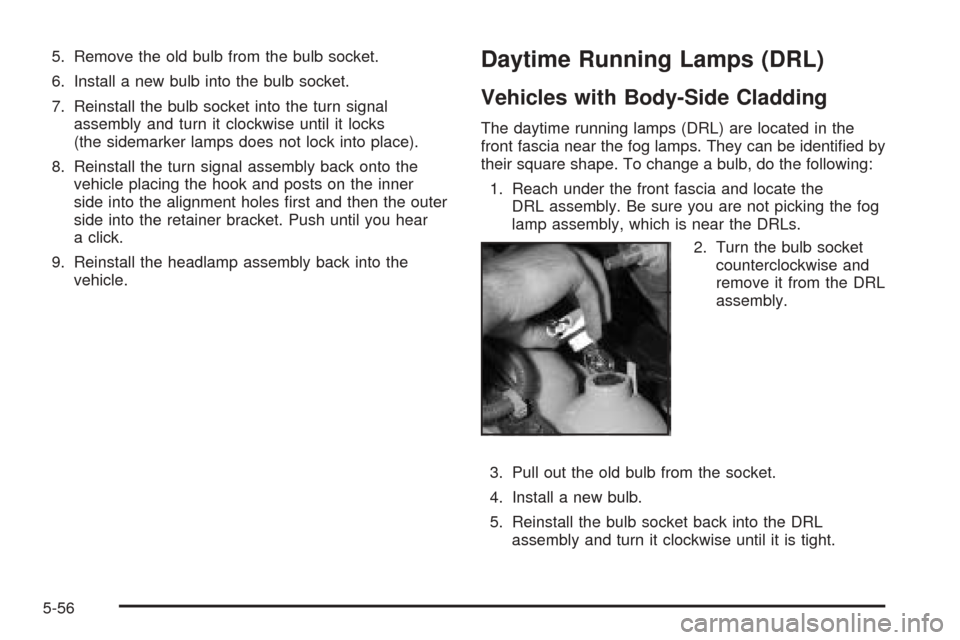
5. Remove the old bulb from the bulb socket.
6. Install a new bulb into the bulb socket.
7. Reinstall the bulb socket into the turn signal
assembly and turn it clockwise until it locks
(the sidemarker lamps does not lock into place).
8. Reinstall the turn signal assembly back onto the
vehicle placing the hook and posts on the inner
side into the alignment holes �rst and then the outer
side into the retainer bracket. Push until you hear
a click.
9. Reinstall the headlamp assembly back into the
vehicle.Daytime Running Lamps (DRL)
Vehicles with Body-Side Cladding
The daytime running lamps (DRL) are located in the
front fascia near the fog lamps. They can be identi�ed by
their square shape. To change a bulb, do the following:
1. Reach under the front fascia and locate the
DRL assembly. Be sure you are not picking the fog
lamp assembly, which is near the DRLs.
2. Turn the bulb socket
counterclockwise and
remove it from the DRL
assembly.
3. Pull out the old bulb from the socket.
4. Install a new bulb.
5. Reinstall the bulb socket back into the DRL
assembly and turn it clockwise until it is tight.
5-56
Page 395 of 496
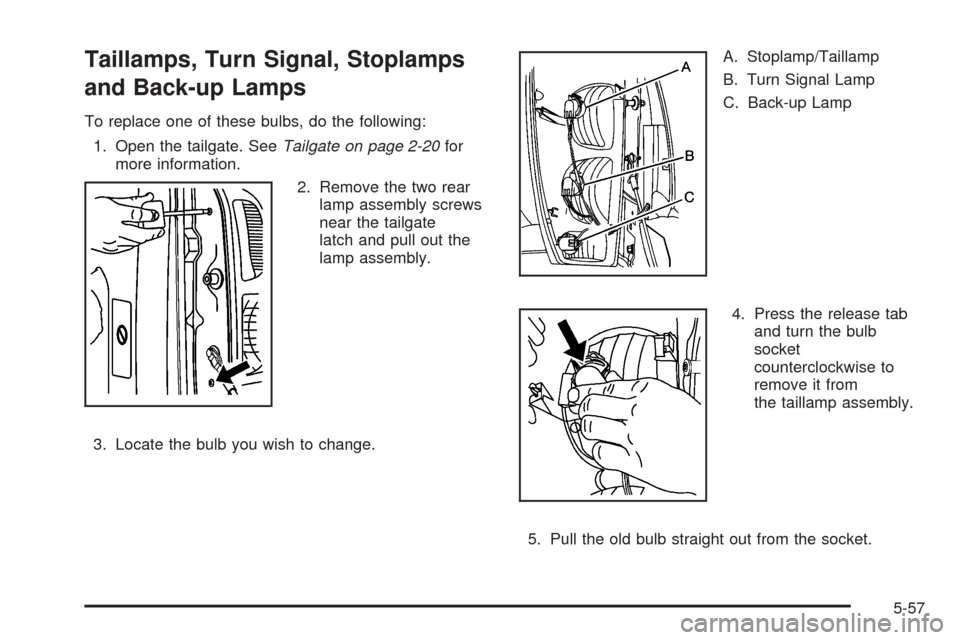
Taillamps, Turn Signal, Stoplamps
and Back-up Lamps
To replace one of these bulbs, do the following:
1. Open the tailgate. SeeTailgate on page 2-20for
more information.
2. Remove the two rear
lamp assembly screws
near the tailgate
latch and pull out the
lamp assembly.
3. Locate the bulb you wish to change.A. Stoplamp/Taillamp
B. Turn Signal Lamp
C. Back-up Lamp
4. Press the release tab
and turn the bulb
socket
counterclockwise to
remove it from
the taillamp assembly.
5. Pull the old bulb straight out from the socket.
5-57
Page 396 of 496
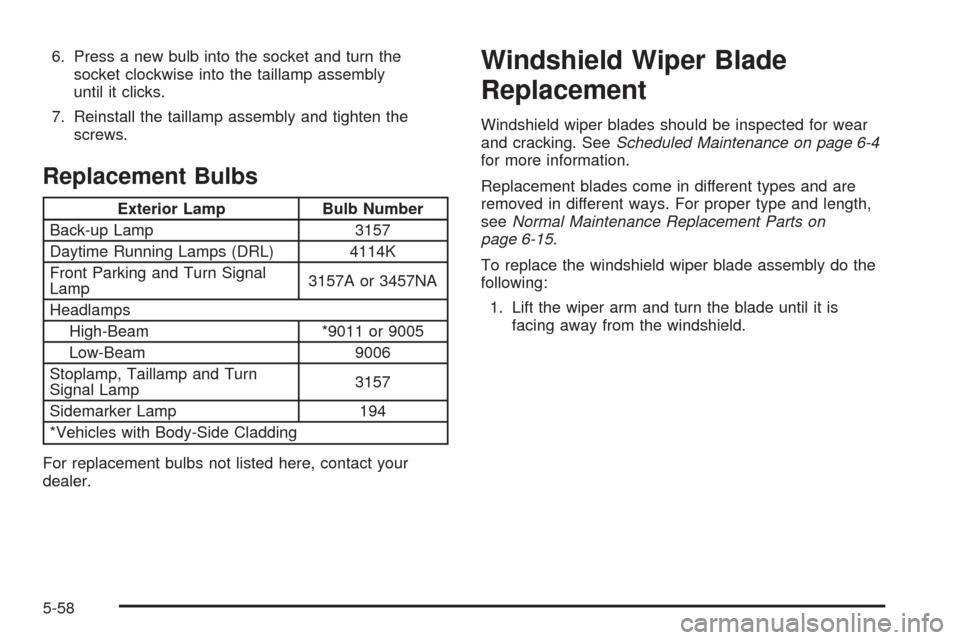
6. Press a new bulb into the socket and turn the
socket clockwise into the taillamp assembly
until it clicks.
7. Reinstall the taillamp assembly and tighten the
screws.
Replacement Bulbs
Exterior Lamp Bulb Number
Back-up Lamp 3157
Daytime Running Lamps (DRL) 4114K
Front Parking and Turn Signal
Lamp3157A or 3457NA
Headlamps
High-Beam *9011 or 9005
Low-Beam 9006
Stoplamp, Taillamp and Turn
Signal Lamp3157
Sidemarker Lamp 194
*Vehicles with Body-Side Cladding
For replacement bulbs not listed here, contact your
dealer.
Windshield Wiper Blade
Replacement
Windshield wiper blades should be inspected for wear
and cracking. SeeScheduled Maintenance on page 6-4
for more information.
Replacement blades come in different types and are
removed in different ways. For proper type and length,
seeNormal Maintenance Replacement Parts on
page 6-15.
To replace the windshield wiper blade assembly do the
following:
1. Lift the wiper arm and turn the blade until it is
facing away from the windshield.
5-58
Page 397 of 496
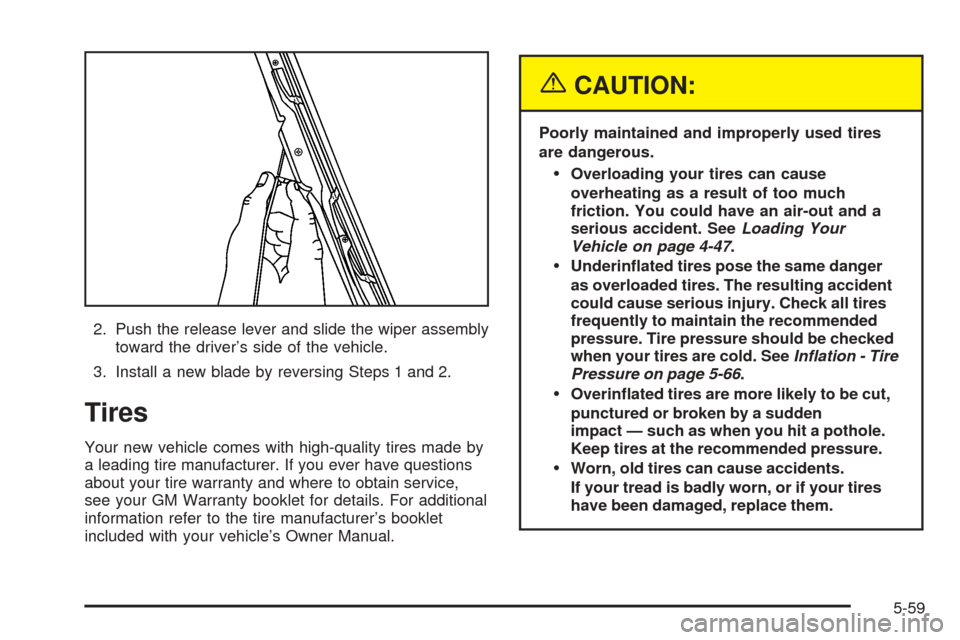
2. Push the release lever and slide the wiper assembly
toward the driver’s side of the vehicle.
3. Install a new blade by reversing Steps 1 and 2.
Tires
Your new vehicle comes with high-quality tires made by
a leading tire manufacturer. If you ever have questions
about your tire warranty and where to obtain service,
see your GM Warranty booklet for details. For additional
information refer to the tire manufacturer’s booklet
included with your vehicle’s Owner Manual.
{CAUTION:
Poorly maintained and improperly used tires
are dangerous.
Overloading your tires can cause
overheating as a result of too much
friction. You could have an air-out and a
serious accident. SeeLoading Your
Vehicle on page 4-47.
Underin�ated tires pose the same danger
as overloaded tires. The resulting accident
could cause serious injury. Check all tires
frequently to maintain the recommended
pressure. Tire pressure should be checked
when your tires are cold. SeeInflation - Tire
Pressure on page 5-66.
Overin�ated tires are more likely to be cut,
punctured or broken by a sudden
impact — such as when you hit a pothole.
Keep tires at the recommended pressure.
Worn, old tires can cause accidents.
If your tread is badly worn, or if your tires
have been damaged, replace them.
5-59
Page 398 of 496
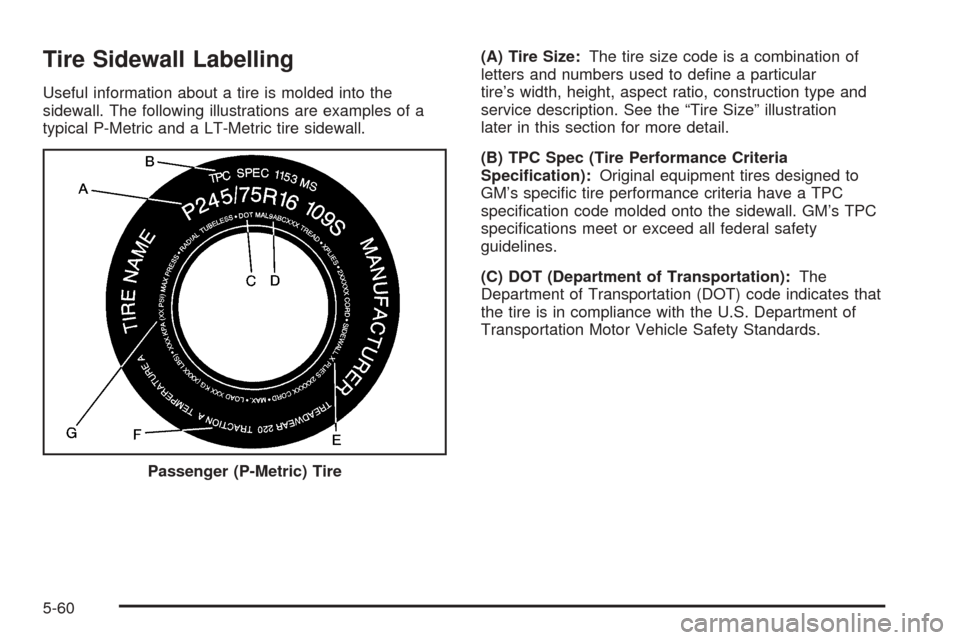
Tire Sidewall Labelling
Useful information about a tire is molded into the
sidewall. The following illustrations are examples of a
typical P-Metric and a LT-Metric tire sidewall.(A) Tire Size:The tire size code is a combination of
letters and numbers used to de�ne a particular
tire’s width, height, aspect ratio, construction type and
service description. See the “Tire Size” illustration
later in this section for more detail.
(B) TPC Spec (Tire Performance Criteria
Speci�cation):Original equipment tires designed to
GM’s speci�c tire performance criteria have a TPC
speci�cation code molded onto the sidewall. GM’s TPC
speci�cations meet or exceed all federal safety
guidelines.
(C) DOT (Department of Transportation):The
Department of Transportation (DOT) code indicates that
the tire is in compliance with the U.S. Department of
Transportation Motor Vehicle Safety Standards.
Passenger (P-Metric) Tire
5-60
Page 399 of 496
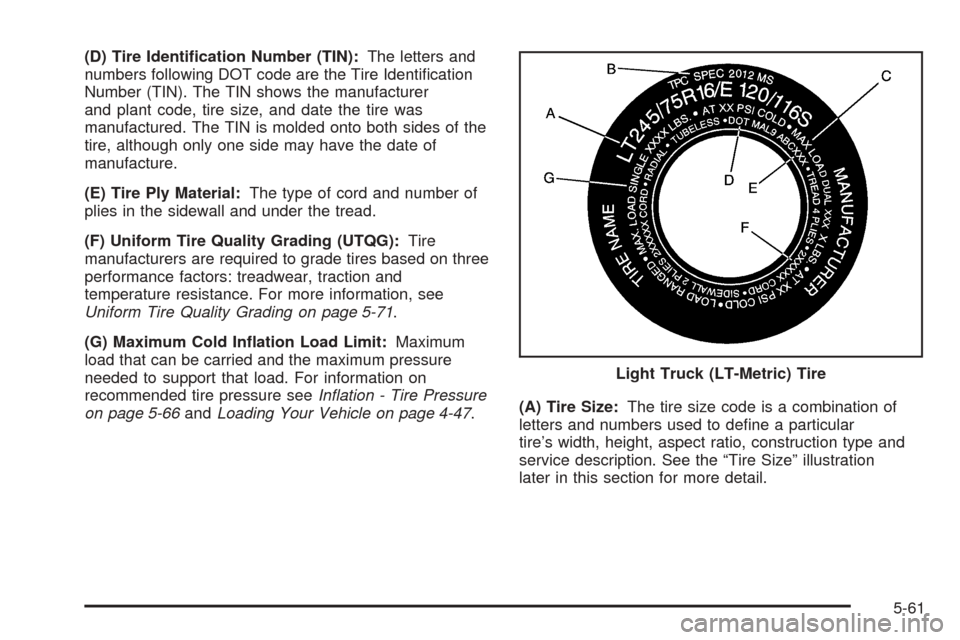
(D) Tire Identi�cation Number (TIN):The letters and
numbers following DOT code are the Tire Identi�cation
Number (TIN). The TIN shows the manufacturer
and plant code, tire size, and date the tire was
manufactured. The TIN is molded onto both sides of the
tire, although only one side may have the date of
manufacture.
(E) Tire Ply Material:The type of cord and number of
plies in the sidewall and under the tread.
(F) Uniform Tire Quality Grading (UTQG):Tire
manufacturers are required to grade tires based on three
performance factors: treadwear, traction and
temperature resistance. For more information, see
Uniform Tire Quality Grading on page 5-71.
(G) Maximum Cold In�ation Load Limit:Maximum
load that can be carried and the maximum pressure
needed to support that load. For information on
recommended tire pressure seeIn�ation - Tire Pressure
on page 5-66andLoading Your Vehicle on page 4-47.(A) Tire Size:The tire size code is a combination of
letters and numbers used to de�ne a particular
tire’s width, height, aspect ratio, construction type and
service description. See the “Tire Size” illustration
later in this section for more detail.Light Truck (LT-Metric) Tire
5-61
Page 400 of 496
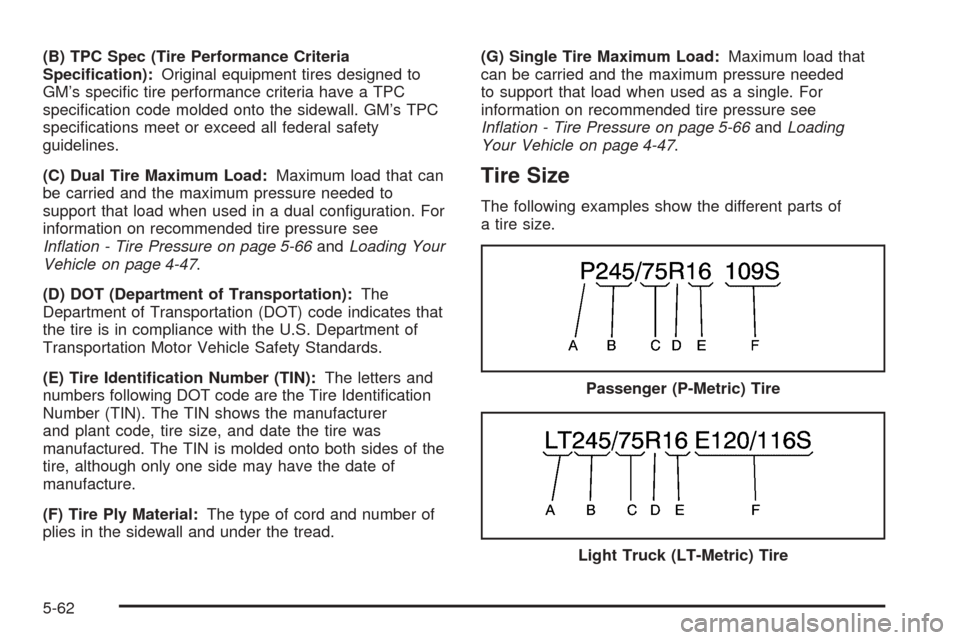
(B) TPC Spec (Tire Performance Criteria
Speci�cation):Original equipment tires designed to
GM’s speci�c tire performance criteria have a TPC
speci�cation code molded onto the sidewall. GM’s TPC
speci�cations meet or exceed all federal safety
guidelines.
(C) Dual Tire Maximum Load:Maximum load that can
be carried and the maximum pressure needed to
support that load when used in a dual con�guration. For
information on recommended tire pressure see
In�ation - Tire Pressure on page 5-66andLoading Your
Vehicle on page 4-47.
(D) DOT (Department of Transportation):The
Department of Transportation (DOT) code indicates that
the tire is in compliance with the U.S. Department of
Transportation Motor Vehicle Safety Standards.
(E) Tire Identi�cation Number (TIN):The letters and
numbers following DOT code are the Tire Identi�cation
Number (TIN). The TIN shows the manufacturer
and plant code, tire size, and date the tire was
manufactured. The TIN is molded onto both sides of the
tire, although only one side may have the date of
manufacture.
(F) Tire Ply Material:The type of cord and number of
plies in the sidewall and under the tread.(G) Single Tire Maximum Load:Maximum load that
can be carried and the maximum pressure needed
to support that load when used as a single. For
information on recommended tire pressure see
In�ation - Tire Pressure on page 5-66andLoading
Your Vehicle on page 4-47.
Tire Size
The following examples show the different parts of
a tire size.
Passenger (P-Metric) Tire
Light Truck (LT-Metric) Tire
5-62